ACC6030 Case Study: Auditing and Assurance of QBE Insurance Group
VerifiedAdded on 2022/12/22
|29
|10383
|77
Case Study
AI Summary
This case study delves into the auditing and assurance of QBE Insurance Group Limited, a major global insurer. It critically evaluates the company's financial statements, focusing on the 'true and fair' representation of its financial position as presented in the annual report. The analysis employs a risk-based auditing approach, examining key audit matters, risk of material misstatement, going concern, corporate governance, materiality in planning and performing the audit, code of ethics, and the auditor's response to risk assessment. The study also examines the application of Australian accounting standards, accounting theories, and the auditor's opinion, providing recommendations based on the findings. The methodology involves a detailed review of the financial report, utilizing both quantitative and qualitative analysis to assess compliance with auditing standards and the accuracy of financial reporting. The study aims to provide a comprehensive understanding of the auditing process and its impact on financial statement reliability.
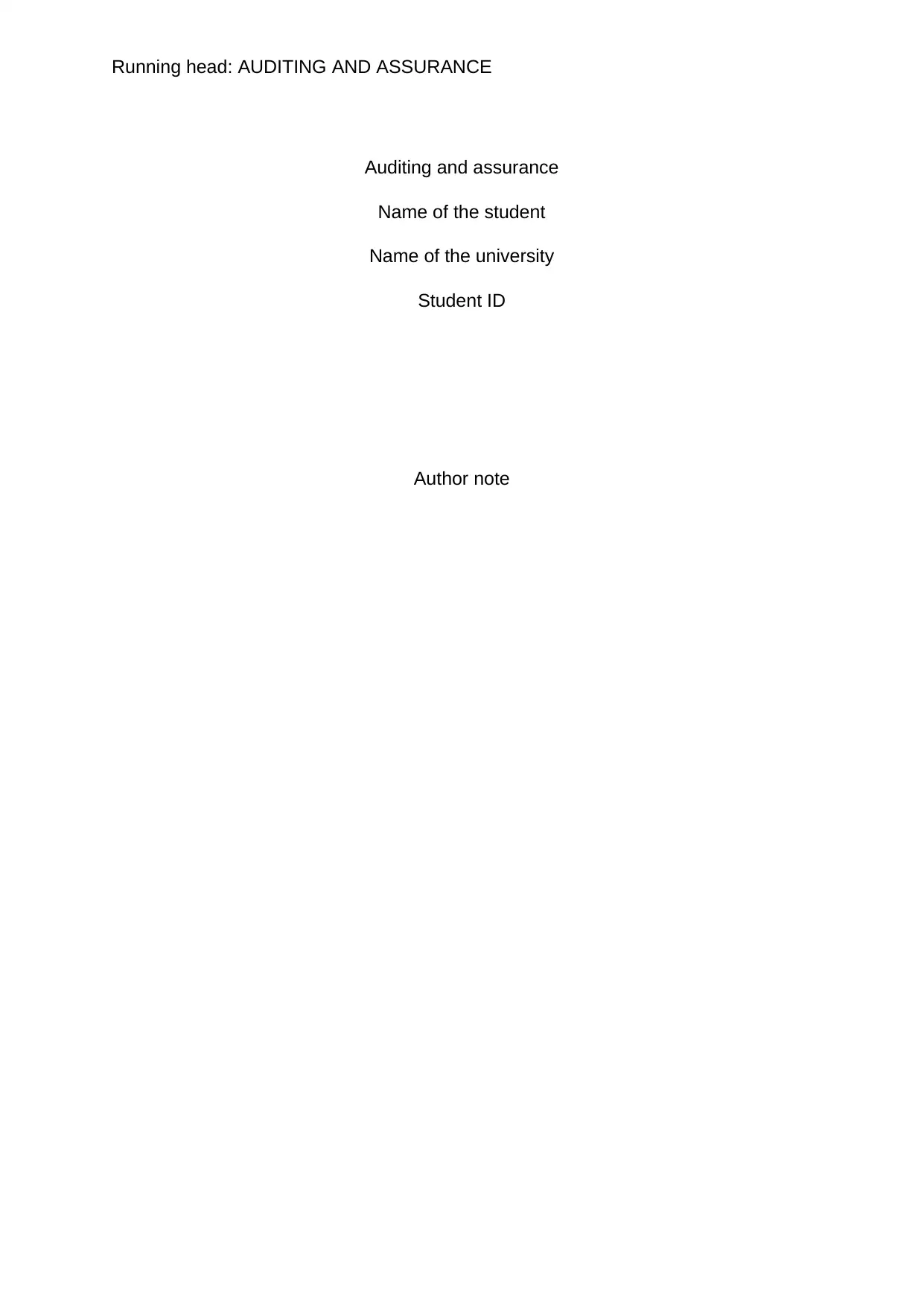
Running head: AUDITING AND ASSURANCE
Auditing and assurance
Name of the student
Name of the university
Student ID
Author note
Auditing and assurance
Name of the student
Name of the university
Student ID
Author note
Paraphrase This Document
Need a fresh take? Get an instant paraphrase of this document with our AI Paraphraser
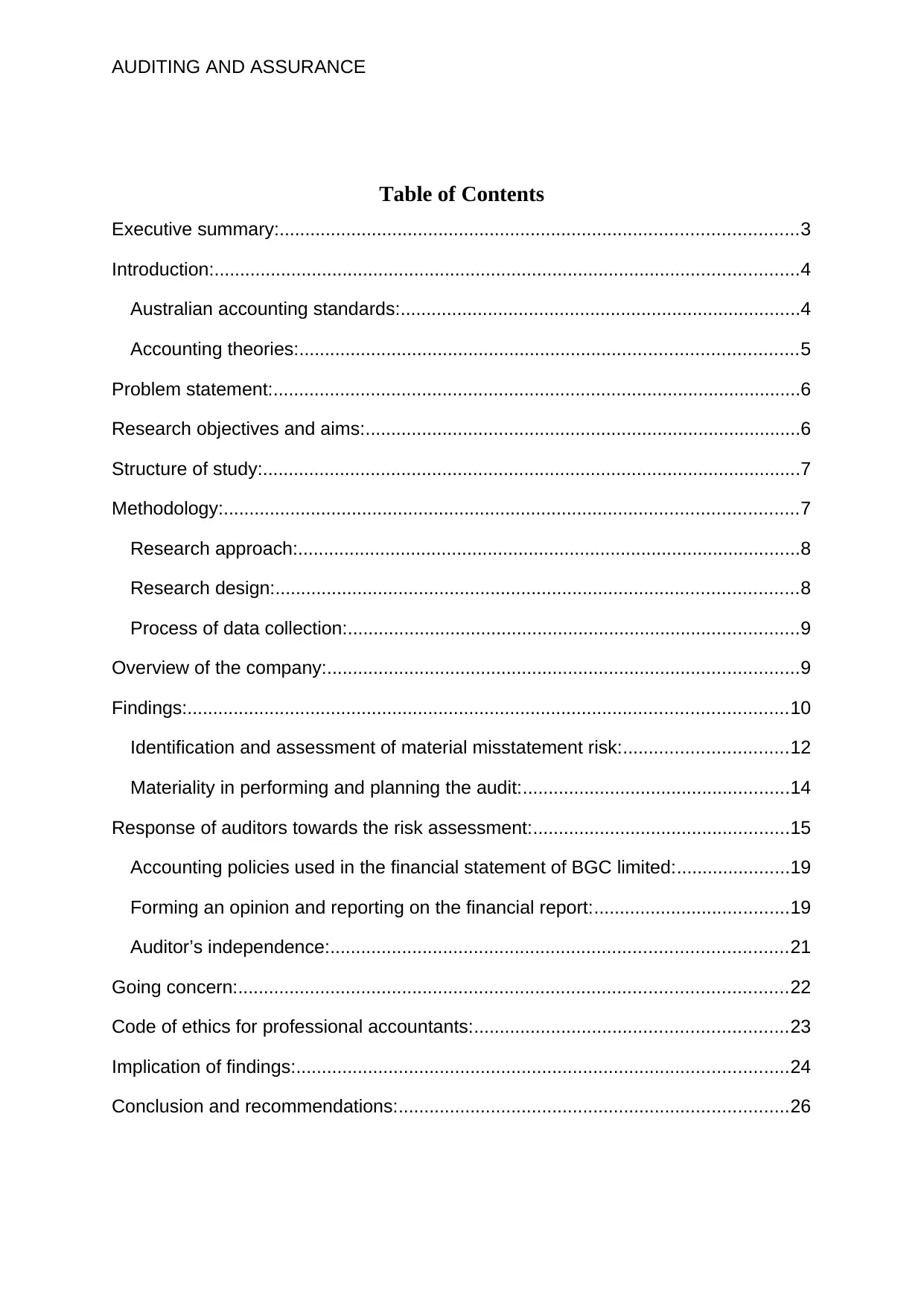
AUDITING AND ASSURANCE
Table of Contents
Executive summary:.....................................................................................................3
Introduction:..................................................................................................................4
Australian accounting standards:..............................................................................4
Accounting theories:.................................................................................................5
Problem statement:.......................................................................................................6
Research objectives and aims:.....................................................................................6
Structure of study:.........................................................................................................7
Methodology:................................................................................................................7
Research approach:..................................................................................................8
Research design:......................................................................................................8
Process of data collection:........................................................................................9
Overview of the company:............................................................................................9
Findings:.....................................................................................................................10
Identification and assessment of material misstatement risk:................................12
Materiality in performing and planning the audit:....................................................14
Response of auditors towards the risk assessment:..................................................15
Accounting policies used in the financial statement of BGC limited:......................19
Forming an opinion and reporting on the financial report:......................................19
Auditor’s independence:.........................................................................................21
Going concern:...........................................................................................................22
Code of ethics for professional accountants:.............................................................23
Implication of findings:................................................................................................24
Conclusion and recommendations:............................................................................26
Table of Contents
Executive summary:.....................................................................................................3
Introduction:..................................................................................................................4
Australian accounting standards:..............................................................................4
Accounting theories:.................................................................................................5
Problem statement:.......................................................................................................6
Research objectives and aims:.....................................................................................6
Structure of study:.........................................................................................................7
Methodology:................................................................................................................7
Research approach:..................................................................................................8
Research design:......................................................................................................8
Process of data collection:........................................................................................9
Overview of the company:............................................................................................9
Findings:.....................................................................................................................10
Identification and assessment of material misstatement risk:................................12
Materiality in performing and planning the audit:....................................................14
Response of auditors towards the risk assessment:..................................................15
Accounting policies used in the financial statement of BGC limited:......................19
Forming an opinion and reporting on the financial report:......................................19
Auditor’s independence:.........................................................................................21
Going concern:...........................................................................................................22
Code of ethics for professional accountants:.............................................................23
Implication of findings:................................................................................................24
Conclusion and recommendations:............................................................................26
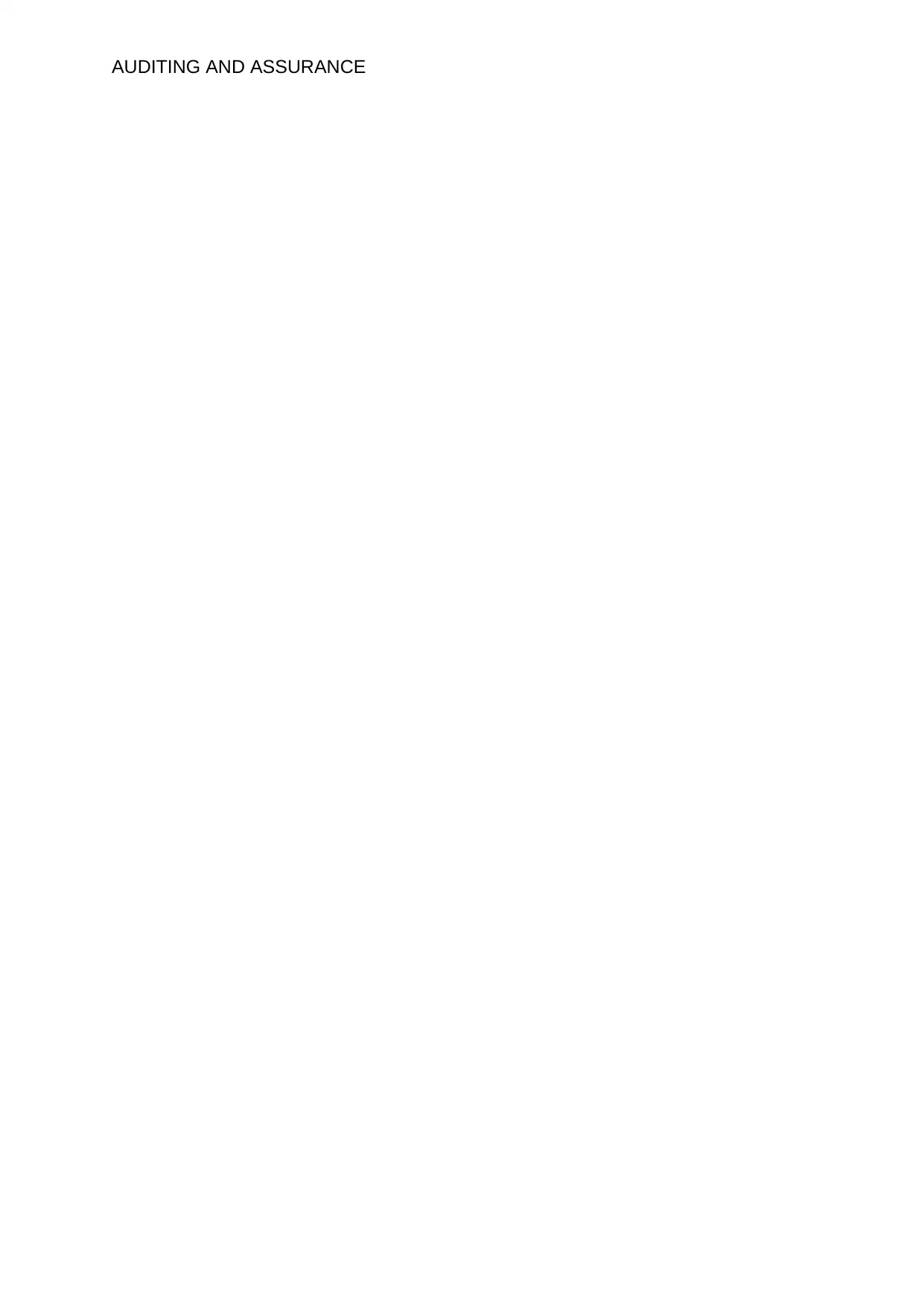
AUDITING AND ASSURANCE
⊘ This is a preview!⊘
Do you want full access?
Subscribe today to unlock all pages.

Trusted by 1+ million students worldwide
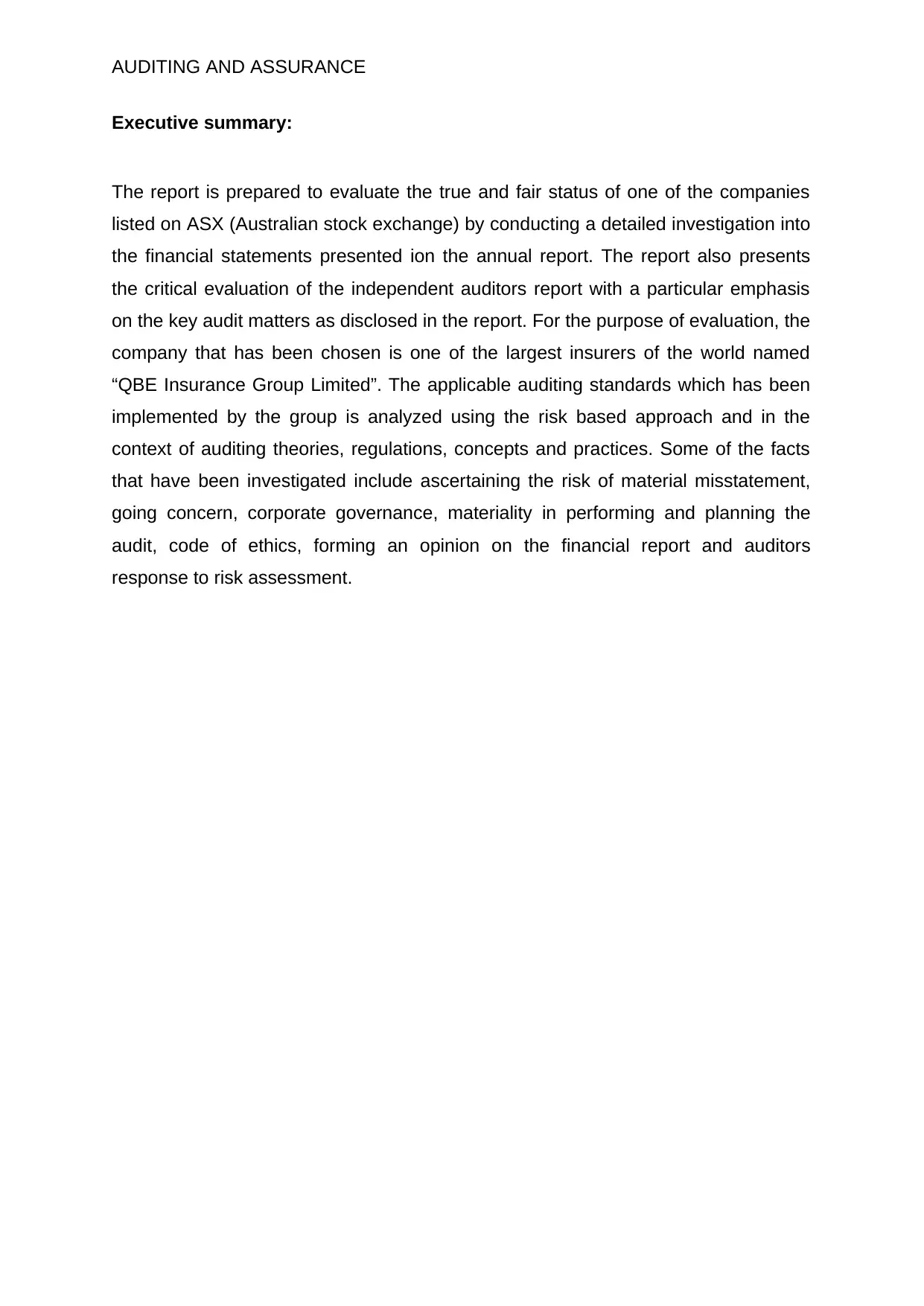
AUDITING AND ASSURANCE
Executive summary:
The report is prepared to evaluate the true and fair status of one of the companies
listed on ASX (Australian stock exchange) by conducting a detailed investigation into
the financial statements presented ion the annual report. The report also presents
the critical evaluation of the independent auditors report with a particular emphasis
on the key audit matters as disclosed in the report. For the purpose of evaluation, the
company that has been chosen is one of the largest insurers of the world named
“QBE Insurance Group Limited”. The applicable auditing standards which has been
implemented by the group is analyzed using the risk based approach and in the
context of auditing theories, regulations, concepts and practices. Some of the facts
that have been investigated include ascertaining the risk of material misstatement,
going concern, corporate governance, materiality in performing and planning the
audit, code of ethics, forming an opinion on the financial report and auditors
response to risk assessment.
Executive summary:
The report is prepared to evaluate the true and fair status of one of the companies
listed on ASX (Australian stock exchange) by conducting a detailed investigation into
the financial statements presented ion the annual report. The report also presents
the critical evaluation of the independent auditors report with a particular emphasis
on the key audit matters as disclosed in the report. For the purpose of evaluation, the
company that has been chosen is one of the largest insurers of the world named
“QBE Insurance Group Limited”. The applicable auditing standards which has been
implemented by the group is analyzed using the risk based approach and in the
context of auditing theories, regulations, concepts and practices. Some of the facts
that have been investigated include ascertaining the risk of material misstatement,
going concern, corporate governance, materiality in performing and planning the
audit, code of ethics, forming an opinion on the financial report and auditors
response to risk assessment.
Paraphrase This Document
Need a fresh take? Get an instant paraphrase of this document with our AI Paraphraser
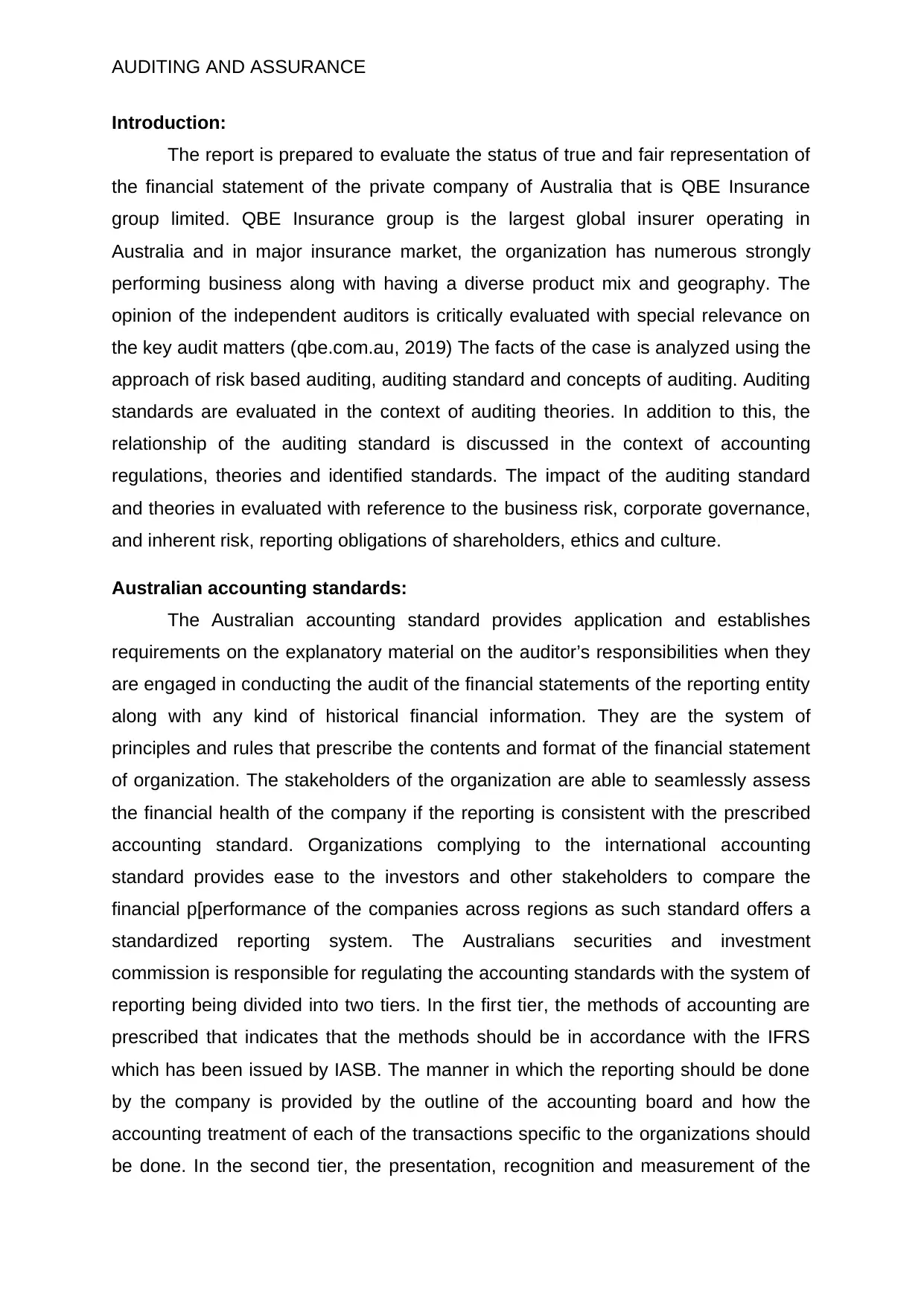
AUDITING AND ASSURANCE
Introduction:
The report is prepared to evaluate the status of true and fair representation of
the financial statement of the private company of Australia that is QBE Insurance
group limited. QBE Insurance group is the largest global insurer operating in
Australia and in major insurance market, the organization has numerous strongly
performing business along with having a diverse product mix and geography. The
opinion of the independent auditors is critically evaluated with special relevance on
the key audit matters (qbe.com.au, 2019) The facts of the case is analyzed using the
approach of risk based auditing, auditing standard and concepts of auditing. Auditing
standards are evaluated in the context of auditing theories. In addition to this, the
relationship of the auditing standard is discussed in the context of accounting
regulations, theories and identified standards. The impact of the auditing standard
and theories in evaluated with reference to the business risk, corporate governance,
and inherent risk, reporting obligations of shareholders, ethics and culture.
Australian accounting standards:
The Australian accounting standard provides application and establishes
requirements on the explanatory material on the auditor’s responsibilities when they
are engaged in conducting the audit of the financial statements of the reporting entity
along with any kind of historical financial information. They are the system of
principles and rules that prescribe the contents and format of the financial statement
of organization. The stakeholders of the organization are able to seamlessly assess
the financial health of the company if the reporting is consistent with the prescribed
accounting standard. Organizations complying to the international accounting
standard provides ease to the investors and other stakeholders to compare the
financial p[performance of the companies across regions as such standard offers a
standardized reporting system. The Australians securities and investment
commission is responsible for regulating the accounting standards with the system of
reporting being divided into two tiers. In the first tier, the methods of accounting are
prescribed that indicates that the methods should be in accordance with the IFRS
which has been issued by IASB. The manner in which the reporting should be done
by the company is provided by the outline of the accounting board and how the
accounting treatment of each of the transactions specific to the organizations should
be done. In the second tier, the presentation, recognition and measurement of the
Introduction:
The report is prepared to evaluate the status of true and fair representation of
the financial statement of the private company of Australia that is QBE Insurance
group limited. QBE Insurance group is the largest global insurer operating in
Australia and in major insurance market, the organization has numerous strongly
performing business along with having a diverse product mix and geography. The
opinion of the independent auditors is critically evaluated with special relevance on
the key audit matters (qbe.com.au, 2019) The facts of the case is analyzed using the
approach of risk based auditing, auditing standard and concepts of auditing. Auditing
standards are evaluated in the context of auditing theories. In addition to this, the
relationship of the auditing standard is discussed in the context of accounting
regulations, theories and identified standards. The impact of the auditing standard
and theories in evaluated with reference to the business risk, corporate governance,
and inherent risk, reporting obligations of shareholders, ethics and culture.
Australian accounting standards:
The Australian accounting standard provides application and establishes
requirements on the explanatory material on the auditor’s responsibilities when they
are engaged in conducting the audit of the financial statements of the reporting entity
along with any kind of historical financial information. They are the system of
principles and rules that prescribe the contents and format of the financial statement
of organization. The stakeholders of the organization are able to seamlessly assess
the financial health of the company if the reporting is consistent with the prescribed
accounting standard. Organizations complying to the international accounting
standard provides ease to the investors and other stakeholders to compare the
financial p[performance of the companies across regions as such standard offers a
standardized reporting system. The Australians securities and investment
commission is responsible for regulating the accounting standards with the system of
reporting being divided into two tiers. In the first tier, the methods of accounting are
prescribed that indicates that the methods should be in accordance with the IFRS
which has been issued by IASB. The manner in which the reporting should be done
by the company is provided by the outline of the accounting board and how the
accounting treatment of each of the transactions specific to the organizations should
be done. In the second tier, the presentation, recognition and measurement of the
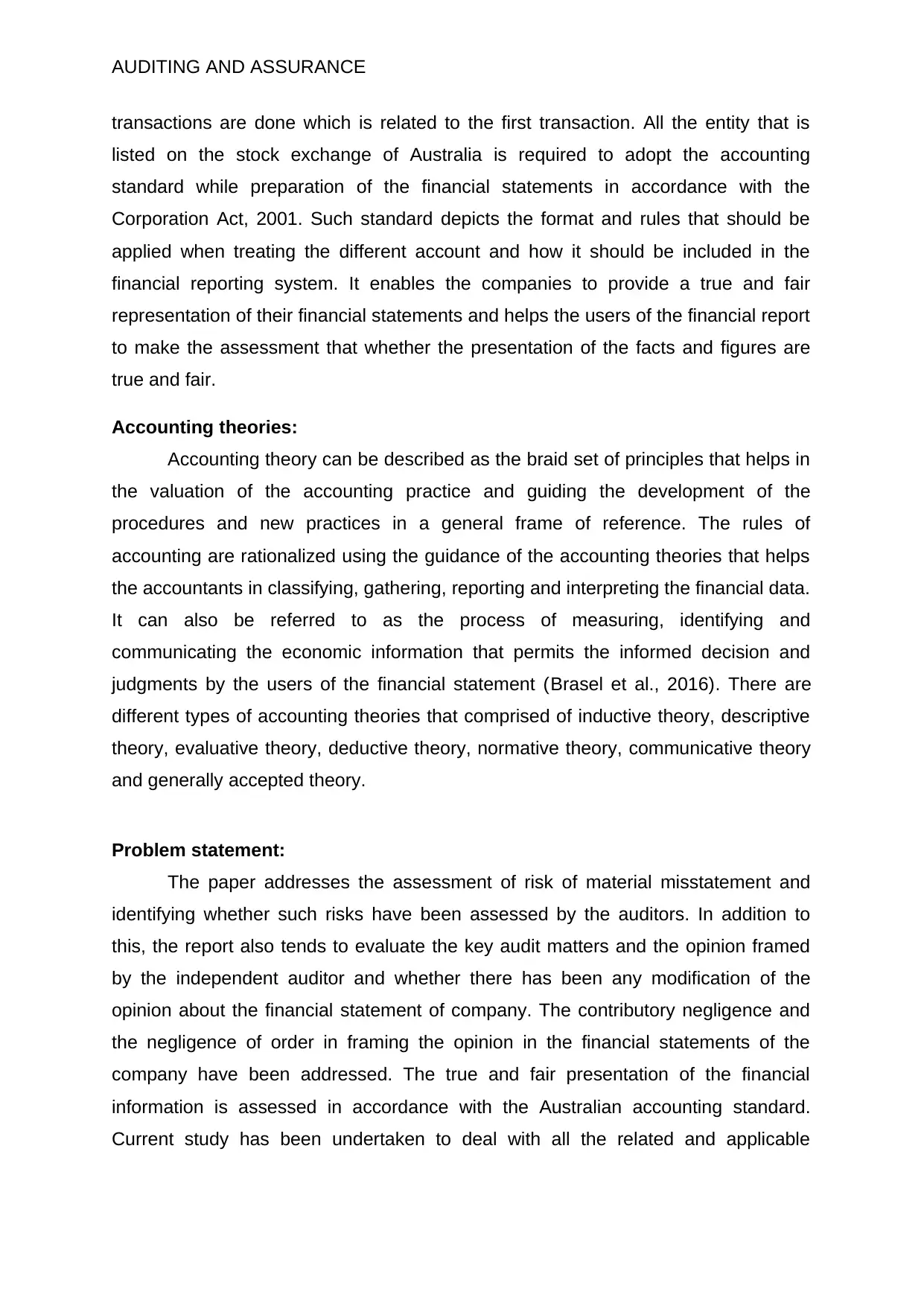
AUDITING AND ASSURANCE
transactions are done which is related to the first transaction. All the entity that is
listed on the stock exchange of Australia is required to adopt the accounting
standard while preparation of the financial statements in accordance with the
Corporation Act, 2001. Such standard depicts the format and rules that should be
applied when treating the different account and how it should be included in the
financial reporting system. It enables the companies to provide a true and fair
representation of their financial statements and helps the users of the financial report
to make the assessment that whether the presentation of the facts and figures are
true and fair.
Accounting theories:
Accounting theory can be described as the braid set of principles that helps in
the valuation of the accounting practice and guiding the development of the
procedures and new practices in a general frame of reference. The rules of
accounting are rationalized using the guidance of the accounting theories that helps
the accountants in classifying, gathering, reporting and interpreting the financial data.
It can also be referred to as the process of measuring, identifying and
communicating the economic information that permits the informed decision and
judgments by the users of the financial statement (Brasel et al., 2016). There are
different types of accounting theories that comprised of inductive theory, descriptive
theory, evaluative theory, deductive theory, normative theory, communicative theory
and generally accepted theory.
Problem statement:
The paper addresses the assessment of risk of material misstatement and
identifying whether such risks have been assessed by the auditors. In addition to
this, the report also tends to evaluate the key audit matters and the opinion framed
by the independent auditor and whether there has been any modification of the
opinion about the financial statement of company. The contributory negligence and
the negligence of order in framing the opinion in the financial statements of the
company have been addressed. The true and fair presentation of the financial
information is assessed in accordance with the Australian accounting standard.
Current study has been undertaken to deal with all the related and applicable
transactions are done which is related to the first transaction. All the entity that is
listed on the stock exchange of Australia is required to adopt the accounting
standard while preparation of the financial statements in accordance with the
Corporation Act, 2001. Such standard depicts the format and rules that should be
applied when treating the different account and how it should be included in the
financial reporting system. It enables the companies to provide a true and fair
representation of their financial statements and helps the users of the financial report
to make the assessment that whether the presentation of the facts and figures are
true and fair.
Accounting theories:
Accounting theory can be described as the braid set of principles that helps in
the valuation of the accounting practice and guiding the development of the
procedures and new practices in a general frame of reference. The rules of
accounting are rationalized using the guidance of the accounting theories that helps
the accountants in classifying, gathering, reporting and interpreting the financial data.
It can also be referred to as the process of measuring, identifying and
communicating the economic information that permits the informed decision and
judgments by the users of the financial statement (Brasel et al., 2016). There are
different types of accounting theories that comprised of inductive theory, descriptive
theory, evaluative theory, deductive theory, normative theory, communicative theory
and generally accepted theory.
Problem statement:
The paper addresses the assessment of risk of material misstatement and
identifying whether such risks have been assessed by the auditors. In addition to
this, the report also tends to evaluate the key audit matters and the opinion framed
by the independent auditor and whether there has been any modification of the
opinion about the financial statement of company. The contributory negligence and
the negligence of order in framing the opinion in the financial statements of the
company have been addressed. The true and fair presentation of the financial
information is assessed in accordance with the Australian accounting standard.
Current study has been undertaken to deal with all the related and applicable
⊘ This is a preview!⊘
Do you want full access?
Subscribe today to unlock all pages.

Trusted by 1+ million students worldwide
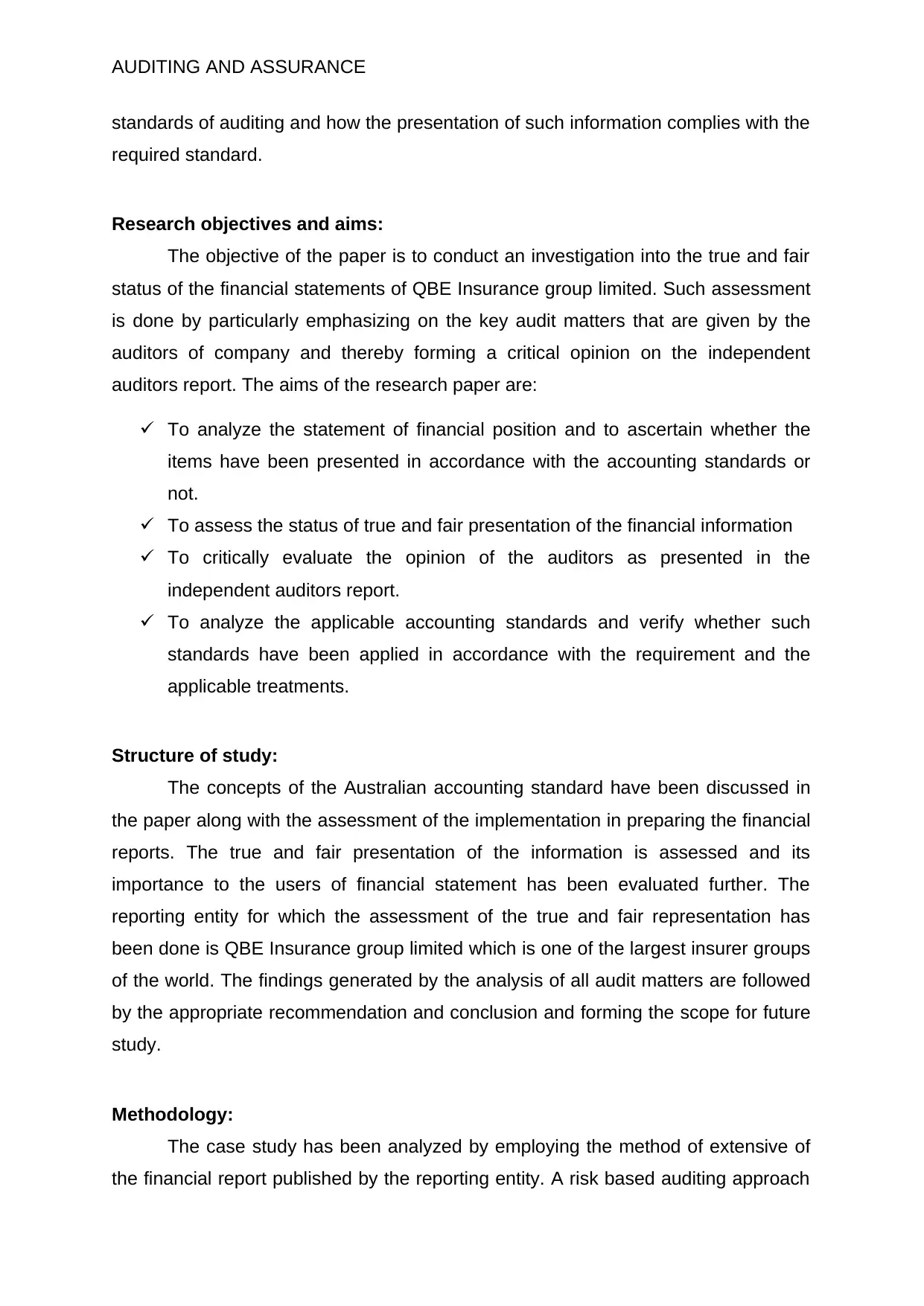
AUDITING AND ASSURANCE
standards of auditing and how the presentation of such information complies with the
required standard.
Research objectives and aims:
The objective of the paper is to conduct an investigation into the true and fair
status of the financial statements of QBE Insurance group limited. Such assessment
is done by particularly emphasizing on the key audit matters that are given by the
auditors of company and thereby forming a critical opinion on the independent
auditors report. The aims of the research paper are:
To analyze the statement of financial position and to ascertain whether the
items have been presented in accordance with the accounting standards or
not.
To assess the status of true and fair presentation of the financial information
To critically evaluate the opinion of the auditors as presented in the
independent auditors report.
To analyze the applicable accounting standards and verify whether such
standards have been applied in accordance with the requirement and the
applicable treatments.
Structure of study:
The concepts of the Australian accounting standard have been discussed in
the paper along with the assessment of the implementation in preparing the financial
reports. The true and fair presentation of the information is assessed and its
importance to the users of financial statement has been evaluated further. The
reporting entity for which the assessment of the true and fair representation has
been done is QBE Insurance group limited which is one of the largest insurer groups
of the world. The findings generated by the analysis of all audit matters are followed
by the appropriate recommendation and conclusion and forming the scope for future
study.
Methodology:
The case study has been analyzed by employing the method of extensive of
the financial report published by the reporting entity. A risk based auditing approach
standards of auditing and how the presentation of such information complies with the
required standard.
Research objectives and aims:
The objective of the paper is to conduct an investigation into the true and fair
status of the financial statements of QBE Insurance group limited. Such assessment
is done by particularly emphasizing on the key audit matters that are given by the
auditors of company and thereby forming a critical opinion on the independent
auditors report. The aims of the research paper are:
To analyze the statement of financial position and to ascertain whether the
items have been presented in accordance with the accounting standards or
not.
To assess the status of true and fair presentation of the financial information
To critically evaluate the opinion of the auditors as presented in the
independent auditors report.
To analyze the applicable accounting standards and verify whether such
standards have been applied in accordance with the requirement and the
applicable treatments.
Structure of study:
The concepts of the Australian accounting standard have been discussed in
the paper along with the assessment of the implementation in preparing the financial
reports. The true and fair presentation of the information is assessed and its
importance to the users of financial statement has been evaluated further. The
reporting entity for which the assessment of the true and fair representation has
been done is QBE Insurance group limited which is one of the largest insurer groups
of the world. The findings generated by the analysis of all audit matters are followed
by the appropriate recommendation and conclusion and forming the scope for future
study.
Methodology:
The case study has been analyzed by employing the method of extensive of
the financial report published by the reporting entity. A risk based auditing approach
Paraphrase This Document
Need a fresh take? Get an instant paraphrase of this document with our AI Paraphraser
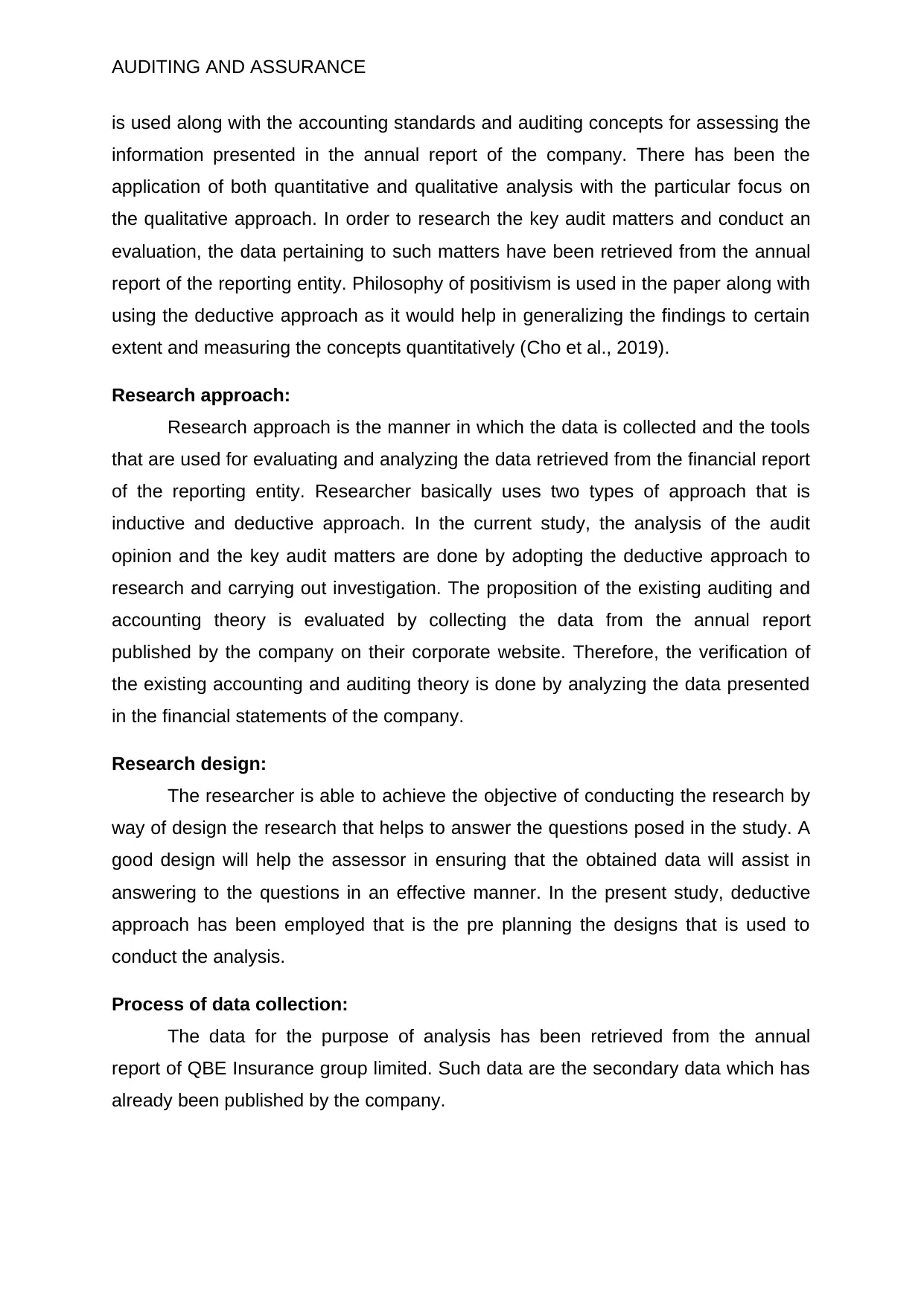
AUDITING AND ASSURANCE
is used along with the accounting standards and auditing concepts for assessing the
information presented in the annual report of the company. There has been the
application of both quantitative and qualitative analysis with the particular focus on
the qualitative approach. In order to research the key audit matters and conduct an
evaluation, the data pertaining to such matters have been retrieved from the annual
report of the reporting entity. Philosophy of positivism is used in the paper along with
using the deductive approach as it would help in generalizing the findings to certain
extent and measuring the concepts quantitatively (Cho et al., 2019).
Research approach:
Research approach is the manner in which the data is collected and the tools
that are used for evaluating and analyzing the data retrieved from the financial report
of the reporting entity. Researcher basically uses two types of approach that is
inductive and deductive approach. In the current study, the analysis of the audit
opinion and the key audit matters are done by adopting the deductive approach to
research and carrying out investigation. The proposition of the existing auditing and
accounting theory is evaluated by collecting the data from the annual report
published by the company on their corporate website. Therefore, the verification of
the existing accounting and auditing theory is done by analyzing the data presented
in the financial statements of the company.
Research design:
The researcher is able to achieve the objective of conducting the research by
way of design the research that helps to answer the questions posed in the study. A
good design will help the assessor in ensuring that the obtained data will assist in
answering to the questions in an effective manner. In the present study, deductive
approach has been employed that is the pre planning the designs that is used to
conduct the analysis.
Process of data collection:
The data for the purpose of analysis has been retrieved from the annual
report of QBE Insurance group limited. Such data are the secondary data which has
already been published by the company.
is used along with the accounting standards and auditing concepts for assessing the
information presented in the annual report of the company. There has been the
application of both quantitative and qualitative analysis with the particular focus on
the qualitative approach. In order to research the key audit matters and conduct an
evaluation, the data pertaining to such matters have been retrieved from the annual
report of the reporting entity. Philosophy of positivism is used in the paper along with
using the deductive approach as it would help in generalizing the findings to certain
extent and measuring the concepts quantitatively (Cho et al., 2019).
Research approach:
Research approach is the manner in which the data is collected and the tools
that are used for evaluating and analyzing the data retrieved from the financial report
of the reporting entity. Researcher basically uses two types of approach that is
inductive and deductive approach. In the current study, the analysis of the audit
opinion and the key audit matters are done by adopting the deductive approach to
research and carrying out investigation. The proposition of the existing auditing and
accounting theory is evaluated by collecting the data from the annual report
published by the company on their corporate website. Therefore, the verification of
the existing accounting and auditing theory is done by analyzing the data presented
in the financial statements of the company.
Research design:
The researcher is able to achieve the objective of conducting the research by
way of design the research that helps to answer the questions posed in the study. A
good design will help the assessor in ensuring that the obtained data will assist in
answering to the questions in an effective manner. In the present study, deductive
approach has been employed that is the pre planning the designs that is used to
conduct the analysis.
Process of data collection:
The data for the purpose of analysis has been retrieved from the annual
report of QBE Insurance group limited. Such data are the secondary data which has
already been published by the company.
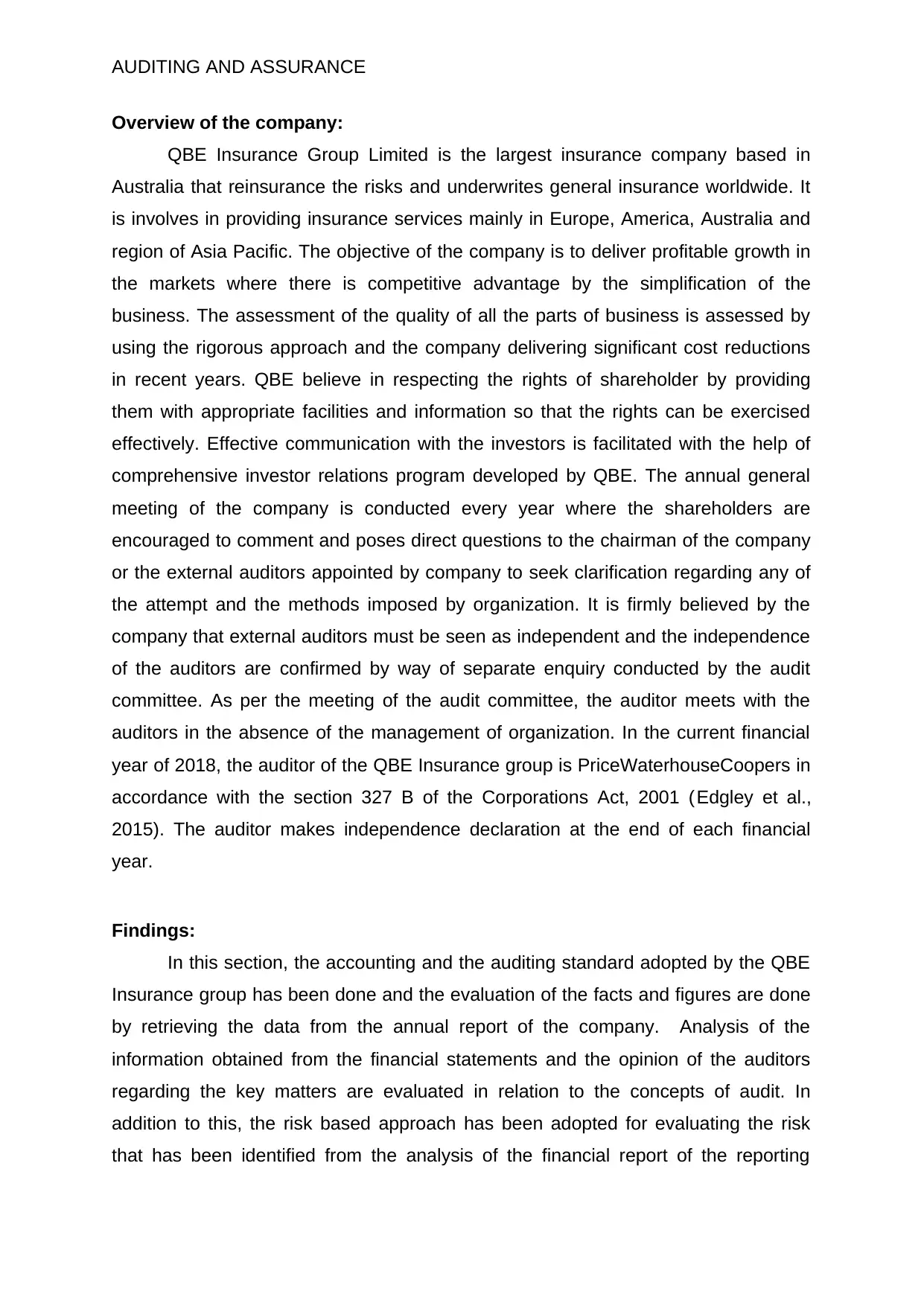
AUDITING AND ASSURANCE
Overview of the company:
QBE Insurance Group Limited is the largest insurance company based in
Australia that reinsurance the risks and underwrites general insurance worldwide. It
is involves in providing insurance services mainly in Europe, America, Australia and
region of Asia Pacific. The objective of the company is to deliver profitable growth in
the markets where there is competitive advantage by the simplification of the
business. The assessment of the quality of all the parts of business is assessed by
using the rigorous approach and the company delivering significant cost reductions
in recent years. QBE believe in respecting the rights of shareholder by providing
them with appropriate facilities and information so that the rights can be exercised
effectively. Effective communication with the investors is facilitated with the help of
comprehensive investor relations program developed by QBE. The annual general
meeting of the company is conducted every year where the shareholders are
encouraged to comment and poses direct questions to the chairman of the company
or the external auditors appointed by company to seek clarification regarding any of
the attempt and the methods imposed by organization. It is firmly believed by the
company that external auditors must be seen as independent and the independence
of the auditors are confirmed by way of separate enquiry conducted by the audit
committee. As per the meeting of the audit committee, the auditor meets with the
auditors in the absence of the management of organization. In the current financial
year of 2018, the auditor of the QBE Insurance group is PriceWaterhouseCoopers in
accordance with the section 327 B of the Corporations Act, 2001 (Edgley et al.,
2015). The auditor makes independence declaration at the end of each financial
year.
Findings:
In this section, the accounting and the auditing standard adopted by the QBE
Insurance group has been done and the evaluation of the facts and figures are done
by retrieving the data from the annual report of the company. Analysis of the
information obtained from the financial statements and the opinion of the auditors
regarding the key matters are evaluated in relation to the concepts of audit. In
addition to this, the risk based approach has been adopted for evaluating the risk
that has been identified from the analysis of the financial report of the reporting
Overview of the company:
QBE Insurance Group Limited is the largest insurance company based in
Australia that reinsurance the risks and underwrites general insurance worldwide. It
is involves in providing insurance services mainly in Europe, America, Australia and
region of Asia Pacific. The objective of the company is to deliver profitable growth in
the markets where there is competitive advantage by the simplification of the
business. The assessment of the quality of all the parts of business is assessed by
using the rigorous approach and the company delivering significant cost reductions
in recent years. QBE believe in respecting the rights of shareholder by providing
them with appropriate facilities and information so that the rights can be exercised
effectively. Effective communication with the investors is facilitated with the help of
comprehensive investor relations program developed by QBE. The annual general
meeting of the company is conducted every year where the shareholders are
encouraged to comment and poses direct questions to the chairman of the company
or the external auditors appointed by company to seek clarification regarding any of
the attempt and the methods imposed by organization. It is firmly believed by the
company that external auditors must be seen as independent and the independence
of the auditors are confirmed by way of separate enquiry conducted by the audit
committee. As per the meeting of the audit committee, the auditor meets with the
auditors in the absence of the management of organization. In the current financial
year of 2018, the auditor of the QBE Insurance group is PriceWaterhouseCoopers in
accordance with the section 327 B of the Corporations Act, 2001 (Edgley et al.,
2015). The auditor makes independence declaration at the end of each financial
year.
Findings:
In this section, the accounting and the auditing standard adopted by the QBE
Insurance group has been done and the evaluation of the facts and figures are done
by retrieving the data from the annual report of the company. Analysis of the
information obtained from the financial statements and the opinion of the auditors
regarding the key matters are evaluated in relation to the concepts of audit. In
addition to this, the risk based approach has been adopted for evaluating the risk
that has been identified from the analysis of the financial report of the reporting
⊘ This is a preview!⊘
Do you want full access?
Subscribe today to unlock all pages.

Trusted by 1+ million students worldwide
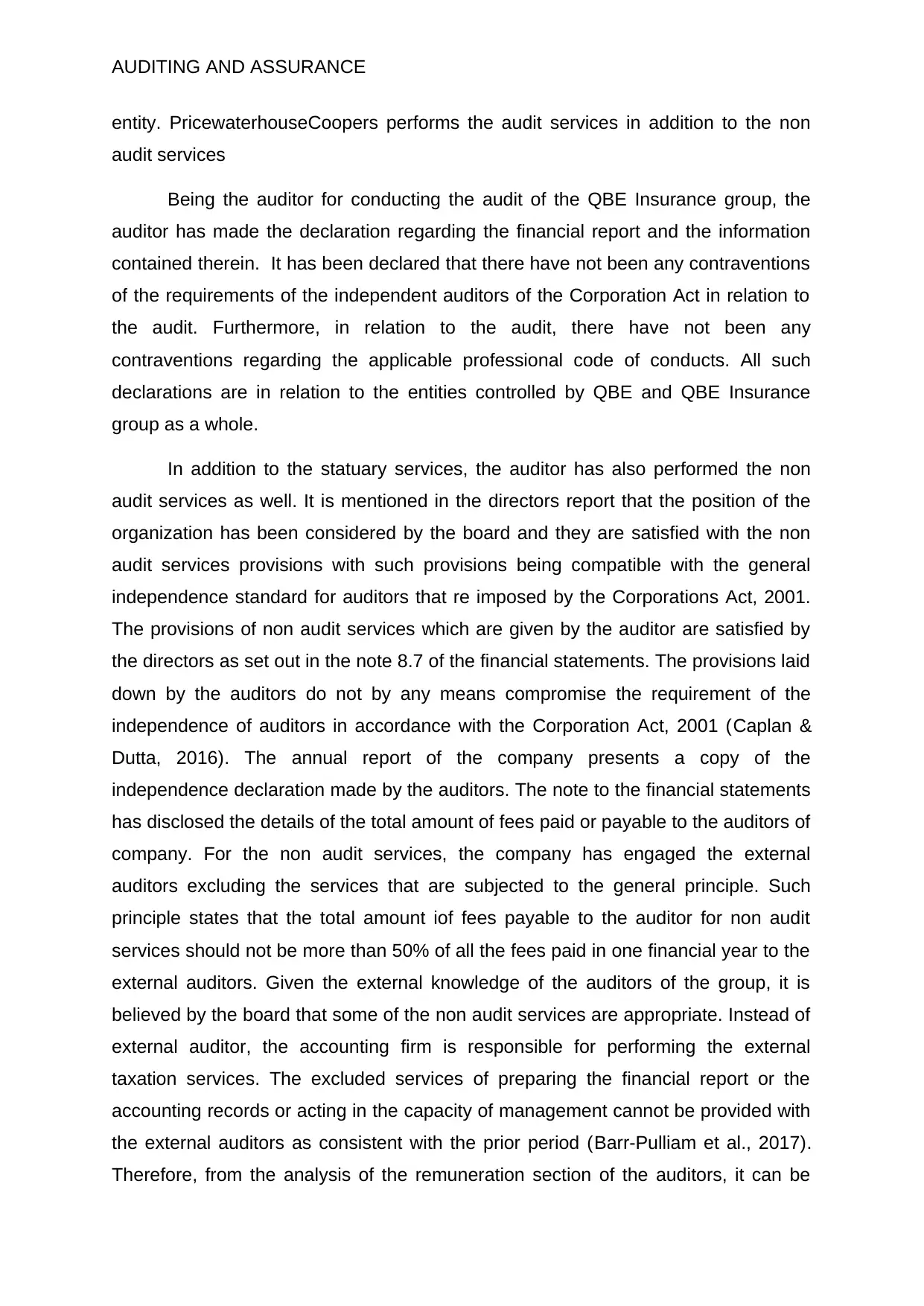
AUDITING AND ASSURANCE
entity. PricewaterhouseCoopers performs the audit services in addition to the non
audit services
Being the auditor for conducting the audit of the QBE Insurance group, the
auditor has made the declaration regarding the financial report and the information
contained therein. It has been declared that there have not been any contraventions
of the requirements of the independent auditors of the Corporation Act in relation to
the audit. Furthermore, in relation to the audit, there have not been any
contraventions regarding the applicable professional code of conducts. All such
declarations are in relation to the entities controlled by QBE and QBE Insurance
group as a whole.
In addition to the statuary services, the auditor has also performed the non
audit services as well. It is mentioned in the directors report that the position of the
organization has been considered by the board and they are satisfied with the non
audit services provisions with such provisions being compatible with the general
independence standard for auditors that re imposed by the Corporations Act, 2001.
The provisions of non audit services which are given by the auditor are satisfied by
the directors as set out in the note 8.7 of the financial statements. The provisions laid
down by the auditors do not by any means compromise the requirement of the
independence of auditors in accordance with the Corporation Act, 2001 (Caplan &
Dutta, 2016). The annual report of the company presents a copy of the
independence declaration made by the auditors. The note to the financial statements
has disclosed the details of the total amount of fees paid or payable to the auditors of
company. For the non audit services, the company has engaged the external
auditors excluding the services that are subjected to the general principle. Such
principle states that the total amount iof fees payable to the auditor for non audit
services should not be more than 50% of all the fees paid in one financial year to the
external auditors. Given the external knowledge of the auditors of the group, it is
believed by the board that some of the non audit services are appropriate. Instead of
external auditor, the accounting firm is responsible for performing the external
taxation services. The excluded services of preparing the financial report or the
accounting records or acting in the capacity of management cannot be provided with
the external auditors as consistent with the prior period (Barr-Pulliam et al., 2017).
Therefore, from the analysis of the remuneration section of the auditors, it can be
entity. PricewaterhouseCoopers performs the audit services in addition to the non
audit services
Being the auditor for conducting the audit of the QBE Insurance group, the
auditor has made the declaration regarding the financial report and the information
contained therein. It has been declared that there have not been any contraventions
of the requirements of the independent auditors of the Corporation Act in relation to
the audit. Furthermore, in relation to the audit, there have not been any
contraventions regarding the applicable professional code of conducts. All such
declarations are in relation to the entities controlled by QBE and QBE Insurance
group as a whole.
In addition to the statuary services, the auditor has also performed the non
audit services as well. It is mentioned in the directors report that the position of the
organization has been considered by the board and they are satisfied with the non
audit services provisions with such provisions being compatible with the general
independence standard for auditors that re imposed by the Corporations Act, 2001.
The provisions of non audit services which are given by the auditor are satisfied by
the directors as set out in the note 8.7 of the financial statements. The provisions laid
down by the auditors do not by any means compromise the requirement of the
independence of auditors in accordance with the Corporation Act, 2001 (Caplan &
Dutta, 2016). The annual report of the company presents a copy of the
independence declaration made by the auditors. The note to the financial statements
has disclosed the details of the total amount of fees paid or payable to the auditors of
company. For the non audit services, the company has engaged the external
auditors excluding the services that are subjected to the general principle. Such
principle states that the total amount iof fees payable to the auditor for non audit
services should not be more than 50% of all the fees paid in one financial year to the
external auditors. Given the external knowledge of the auditors of the group, it is
believed by the board that some of the non audit services are appropriate. Instead of
external auditor, the accounting firm is responsible for performing the external
taxation services. The excluded services of preparing the financial report or the
accounting records or acting in the capacity of management cannot be provided with
the external auditors as consistent with the prior period (Barr-Pulliam et al., 2017).
Therefore, from the analysis of the remuneration section of the auditors, it can be
Paraphrase This Document
Need a fresh take? Get an instant paraphrase of this document with our AI Paraphraser
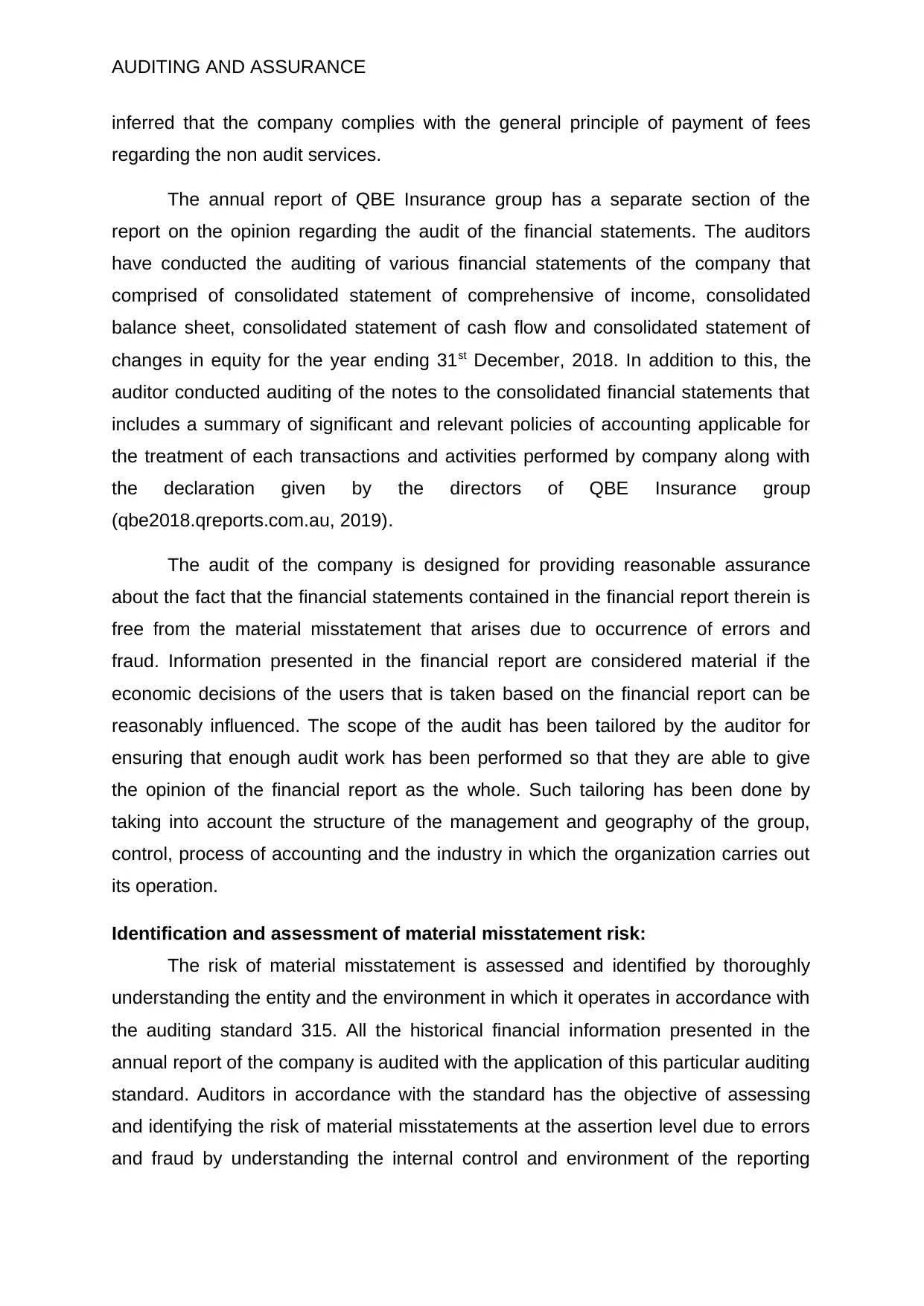
AUDITING AND ASSURANCE
inferred that the company complies with the general principle of payment of fees
regarding the non audit services.
The annual report of QBE Insurance group has a separate section of the
report on the opinion regarding the audit of the financial statements. The auditors
have conducted the auditing of various financial statements of the company that
comprised of consolidated statement of comprehensive of income, consolidated
balance sheet, consolidated statement of cash flow and consolidated statement of
changes in equity for the year ending 31st December, 2018. In addition to this, the
auditor conducted auditing of the notes to the consolidated financial statements that
includes a summary of significant and relevant policies of accounting applicable for
the treatment of each transactions and activities performed by company along with
the declaration given by the directors of QBE Insurance group
(qbe2018.qreports.com.au, 2019).
The audit of the company is designed for providing reasonable assurance
about the fact that the financial statements contained in the financial report therein is
free from the material misstatement that arises due to occurrence of errors and
fraud. Information presented in the financial report are considered material if the
economic decisions of the users that is taken based on the financial report can be
reasonably influenced. The scope of the audit has been tailored by the auditor for
ensuring that enough audit work has been performed so that they are able to give
the opinion of the financial report as the whole. Such tailoring has been done by
taking into account the structure of the management and geography of the group,
control, process of accounting and the industry in which the organization carries out
its operation.
Identification and assessment of material misstatement risk:
The risk of material misstatement is assessed and identified by thoroughly
understanding the entity and the environment in which it operates in accordance with
the auditing standard 315. All the historical financial information presented in the
annual report of the company is audited with the application of this particular auditing
standard. Auditors in accordance with the standard has the objective of assessing
and identifying the risk of material misstatements at the assertion level due to errors
and fraud by understanding the internal control and environment of the reporting
inferred that the company complies with the general principle of payment of fees
regarding the non audit services.
The annual report of QBE Insurance group has a separate section of the
report on the opinion regarding the audit of the financial statements. The auditors
have conducted the auditing of various financial statements of the company that
comprised of consolidated statement of comprehensive of income, consolidated
balance sheet, consolidated statement of cash flow and consolidated statement of
changes in equity for the year ending 31st December, 2018. In addition to this, the
auditor conducted auditing of the notes to the consolidated financial statements that
includes a summary of significant and relevant policies of accounting applicable for
the treatment of each transactions and activities performed by company along with
the declaration given by the directors of QBE Insurance group
(qbe2018.qreports.com.au, 2019).
The audit of the company is designed for providing reasonable assurance
about the fact that the financial statements contained in the financial report therein is
free from the material misstatement that arises due to occurrence of errors and
fraud. Information presented in the financial report are considered material if the
economic decisions of the users that is taken based on the financial report can be
reasonably influenced. The scope of the audit has been tailored by the auditor for
ensuring that enough audit work has been performed so that they are able to give
the opinion of the financial report as the whole. Such tailoring has been done by
taking into account the structure of the management and geography of the group,
control, process of accounting and the industry in which the organization carries out
its operation.
Identification and assessment of material misstatement risk:
The risk of material misstatement is assessed and identified by thoroughly
understanding the entity and the environment in which it operates in accordance with
the auditing standard 315. All the historical financial information presented in the
annual report of the company is audited with the application of this particular auditing
standard. Auditors in accordance with the standard has the objective of assessing
and identifying the risk of material misstatements at the assertion level due to errors
and fraud by understanding the internal control and environment of the reporting
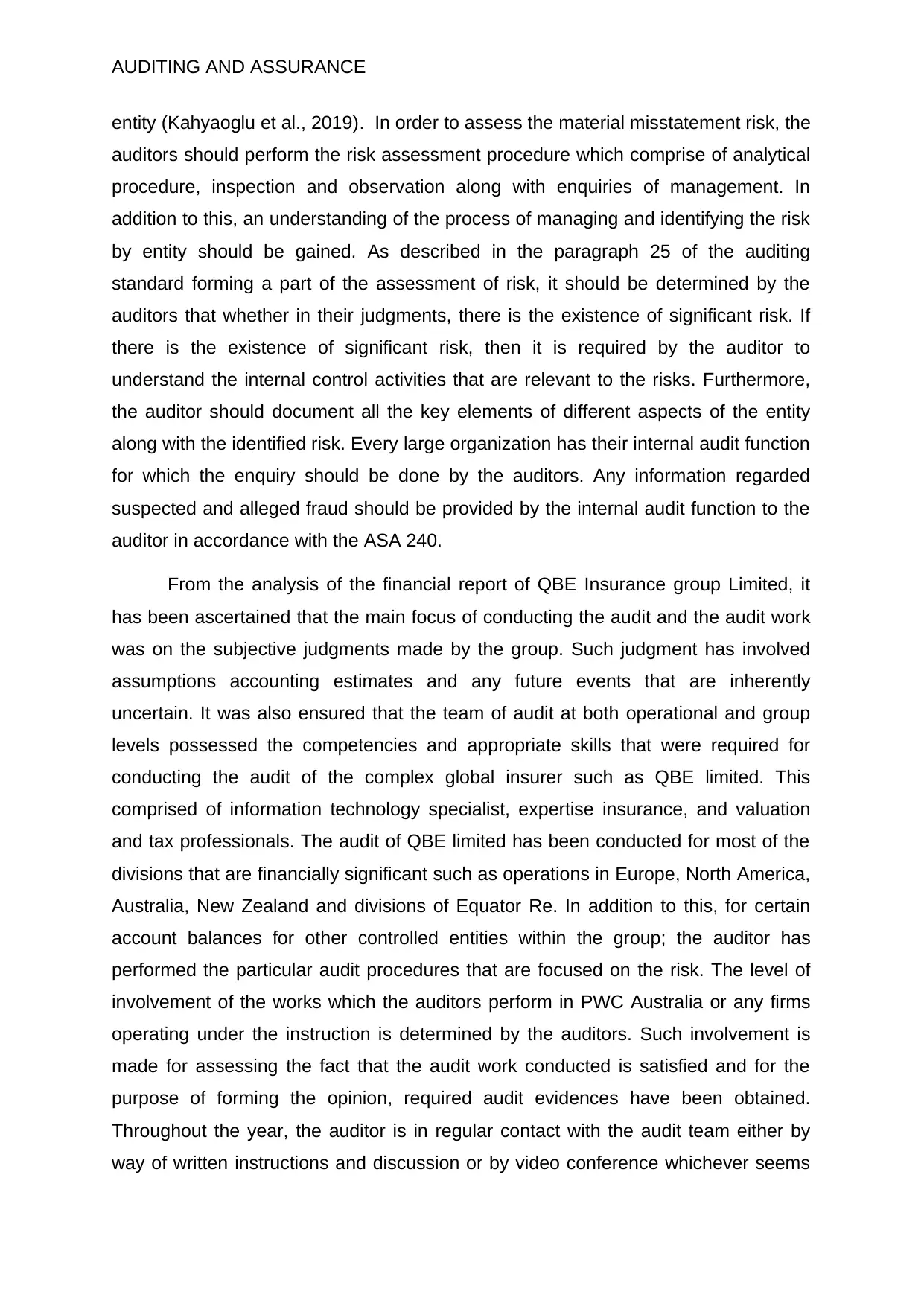
AUDITING AND ASSURANCE
entity (Kahyaoglu et al., 2019). In order to assess the material misstatement risk, the
auditors should perform the risk assessment procedure which comprise of analytical
procedure, inspection and observation along with enquiries of management. In
addition to this, an understanding of the process of managing and identifying the risk
by entity should be gained. As described in the paragraph 25 of the auditing
standard forming a part of the assessment of risk, it should be determined by the
auditors that whether in their judgments, there is the existence of significant risk. If
there is the existence of significant risk, then it is required by the auditor to
understand the internal control activities that are relevant to the risks. Furthermore,
the auditor should document all the key elements of different aspects of the entity
along with the identified risk. Every large organization has their internal audit function
for which the enquiry should be done by the auditors. Any information regarded
suspected and alleged fraud should be provided by the internal audit function to the
auditor in accordance with the ASA 240.
From the analysis of the financial report of QBE Insurance group Limited, it
has been ascertained that the main focus of conducting the audit and the audit work
was on the subjective judgments made by the group. Such judgment has involved
assumptions accounting estimates and any future events that are inherently
uncertain. It was also ensured that the team of audit at both operational and group
levels possessed the competencies and appropriate skills that were required for
conducting the audit of the complex global insurer such as QBE limited. This
comprised of information technology specialist, expertise insurance, and valuation
and tax professionals. The audit of QBE limited has been conducted for most of the
divisions that are financially significant such as operations in Europe, North America,
Australia, New Zealand and divisions of Equator Re. In addition to this, for certain
account balances for other controlled entities within the group; the auditor has
performed the particular audit procedures that are focused on the risk. The level of
involvement of the works which the auditors perform in PWC Australia or any firms
operating under the instruction is determined by the auditors. Such involvement is
made for assessing the fact that the audit work conducted is satisfied and for the
purpose of forming the opinion, required audit evidences have been obtained.
Throughout the year, the auditor is in regular contact with the audit team either by
way of written instructions and discussion or by video conference whichever seems
entity (Kahyaoglu et al., 2019). In order to assess the material misstatement risk, the
auditors should perform the risk assessment procedure which comprise of analytical
procedure, inspection and observation along with enquiries of management. In
addition to this, an understanding of the process of managing and identifying the risk
by entity should be gained. As described in the paragraph 25 of the auditing
standard forming a part of the assessment of risk, it should be determined by the
auditors that whether in their judgments, there is the existence of significant risk. If
there is the existence of significant risk, then it is required by the auditor to
understand the internal control activities that are relevant to the risks. Furthermore,
the auditor should document all the key elements of different aspects of the entity
along with the identified risk. Every large organization has their internal audit function
for which the enquiry should be done by the auditors. Any information regarded
suspected and alleged fraud should be provided by the internal audit function to the
auditor in accordance with the ASA 240.
From the analysis of the financial report of QBE Insurance group Limited, it
has been ascertained that the main focus of conducting the audit and the audit work
was on the subjective judgments made by the group. Such judgment has involved
assumptions accounting estimates and any future events that are inherently
uncertain. It was also ensured that the team of audit at both operational and group
levels possessed the competencies and appropriate skills that were required for
conducting the audit of the complex global insurer such as QBE limited. This
comprised of information technology specialist, expertise insurance, and valuation
and tax professionals. The audit of QBE limited has been conducted for most of the
divisions that are financially significant such as operations in Europe, North America,
Australia, New Zealand and divisions of Equator Re. In addition to this, for certain
account balances for other controlled entities within the group; the auditor has
performed the particular audit procedures that are focused on the risk. The level of
involvement of the works which the auditors perform in PWC Australia or any firms
operating under the instruction is determined by the auditors. Such involvement is
made for assessing the fact that the audit work conducted is satisfied and for the
purpose of forming the opinion, required audit evidences have been obtained.
Throughout the year, the auditor is in regular contact with the audit team either by
way of written instructions and discussion or by video conference whichever seems
⊘ This is a preview!⊘
Do you want full access?
Subscribe today to unlock all pages.

Trusted by 1+ million students worldwide
1 out of 29
Related Documents
Your All-in-One AI-Powered Toolkit for Academic Success.
+13062052269
info@desklib.com
Available 24*7 on WhatsApp / Email
![[object Object]](/_next/static/media/star-bottom.7253800d.svg)
Unlock your academic potential
Copyright © 2020–2025 A2Z Services. All Rights Reserved. Developed and managed by ZUCOL.




